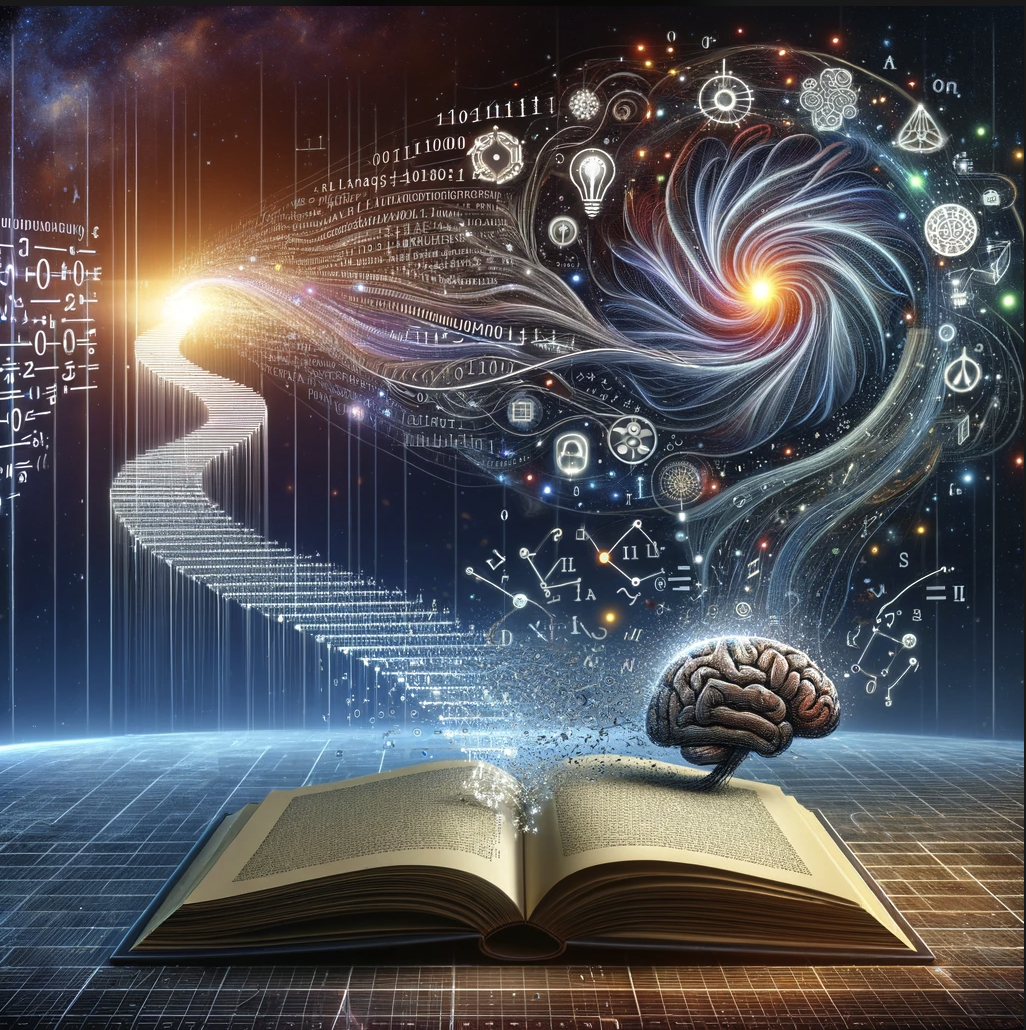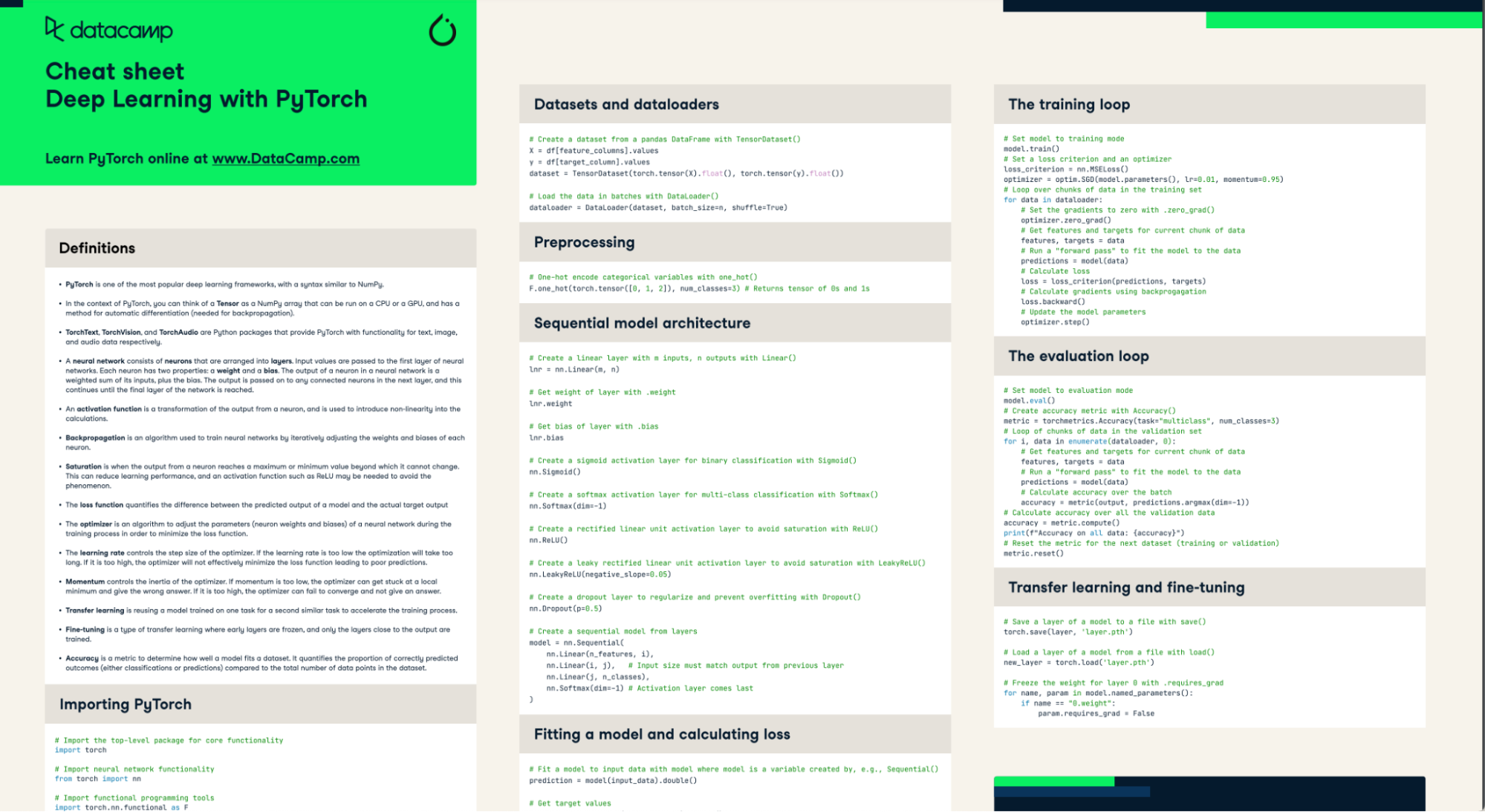Curso
El aprendizaje profundo es una parte transformadora de la inteligencia artificial (IA), que ayuda a impulsar innovaciones desde vehículos autónomos hasta modelos lingüísticos avanzados como el GPT-4. Este artículo pretende esbozar un camino estructurado para aprender el aprendizaje profundo y llegar a dominarlo. Aunque el aprendizaje profundo representa un conjunto de habilidades más especializadas dentro de la IA, se basa en conceptos fundamentales del aprendizaje automático y la IA. Por lo tanto, si eres completamente nuevo en el aprendizaje profundo, te recomendamos encarecidamente que empieces con nuestras guías sobre Cómo aprender aprendizaje automático o Cómo aprender IA.
¿Qué es el Aprendizaje Profundo?
El aprendizaje profundo es un subconjunto de vanguardia del aprendizaje automático que imita el funcionamiento del cerebro humano en el procesamiento de datos y la creación de patrones para su uso en la toma de decisiones. Es una tecnología clave detrás de muchas aplicaciones avanzadas, como el procesamiento del lenguaje natural, la visión por ordenador y el reconocimiento de voz, que permite a las máquinas realizar tareas complejas sin programación explícita. Al aprovechar las redes neuronales con muchas capas, los modelos de aprendizaje profundo pueden analizar grandes volúmenes de datos, aprendiendo estructuras y patrones intrincados, lo que los convierte en una poderosa herramienta para el desarrollo de la IA.
Casos de uso populares del aprendizaje profundo
La tecnología del aprendizaje profundo impulsa muchas aplicaciones que influyen en nuestra vida cotidiana y en las industrias. He aquí algunos ejemplos notables:
- Reconocimiento de imágenes y vídeos: Los algoritmos de aprendizaje profundo destacan en el reconocimiento de patrones y objetos dentro de imágenes y vídeos, permitiendo funcionalidades como el reconocimiento facial y la navegación autónoma de vehículos.
- Procesamiento del Lenguaje Natural (PLN): Esto implica comprender y generar el lenguaje humano y facilitar tecnologías como los servicios de traducción lingüística, los chatbots y los asistentes virtuales. ChatGPT, por ejemplo, se basa en algoritmos de aprendizaje profundo.
- Finanzas: En el sector financiero, el aprendizaje profundo se utiliza para la detección del fraude, la negociación algorítmica y la gestión del riesgo.
- Reconocimiento y generación de voz: Estos sistemas comprenden y generan el habla humana, potenciando los asistentes activados por voz y permitiendo la traducción de idiomas en tiempo real.
¿Por qué aprender Deep Learning en 2024?
Tanto si eres un recién llegado como si ya tienes cierta experiencia, hay muchas razones para aprender aprendizaje profundo. He aquí tres razones:
- Demanda de empleo: La demanda de puestos de aprendizaje automático se está disparando, y los conocimientos de aprendizaje profundo están muy solicitados. Esta experiencia es crucial para los proyectos e innovaciones de vanguardia en IA. Las empresas de diversos sectores están invirtiendo mucho en IA, lo que convierte al aprendizaje profundo en una valiosa habilidad para progresar profesionalmente.
- Salarios atractivos: Los puestos relacionados con el aprendizaje profundo se encuentran entre los mejor pagados del sector tecnológico, lo que refleja el avanzado conjunto de habilidades y conocimientos necesarios. Por ejemplo, el salario medio de un ingeniero de aprendizaje profundo en Estados Unidos puede variar significativamente, con cifras como 146.000 dólares al año como mediana y una compensación total potencial que alcanza más de 181.000 dólares, lo que ilustra la naturaleza lucrativa de especializarse en este campo..
- Desafío intelectual: Los continuos avances en los algoritmos de aprendizaje profundo y en la potencia de cálculo hacen que sea un momento apasionante para adentrarse en este campo, ya que ofrece la posibilidad de trabajar en tecnologías transformadoras y contribuir a futuros avances.

¿Cuánto se tarda en aprender Deep Learning?
El camino hacia el dominio del aprendizaje profundo varía enormemente en función de tu formación, dedicación y los recursos de aprendizaje que utilices. Si eres un completo principiante, te recomendamos encarecidamente que empieces por el aprendizaje automático, ya que es una pieza fundamental del aprendizaje profundo. Para ello, consulta nuestra guía sobre cómo aprender aprendizaje automático.
Para quienes ya se sientan cómodos con el aprendizaje automático, adentrarse en el aprendizaje profundo podría llevarles aproximadamente de 3 a 4 meses para alcanzar la competencia. Esta estimación presupone un programa de aprendizaje coherente y la aplicación práctica de las competencias mediante proyectos. Sin embargo, el aprendizaje profundo es un campo vasto y en rápida evolución, por lo que el aprendizaje y la adaptación continuos son fundamentales para mantenerse al día.
Cómo aprender Deep Learning en 2024
Emprender el viaje hacia el aprendizaje profundo requiere un enfoque estratégico, que combine los conocimientos teóricos con la aplicación práctica. Aquí tienes 3 pasos que puedes dar para aprender aprendizaje profundo en 2024.
1. Repasa los requisitos previos
Antes de sumergirte en el aprendizaje profundo, es crucial garantizar una base sólida en las siguientes áreas:
- Estadística y Matemáticas Básicas: Comprender la probabilidad, la estadística, el álgebra lineal y el cálculo es esencial para entender los principios subyacentes de los algoritmos de aprendizaje profundo.
- Estructuras y Manipulación de Datos: La competencia en el manejo y procesamiento de datos es vital, ya que el aprendizaje profundo implica trabajar con grandes conjuntos de datos.
- Teoría y aplicaciones del aprendizaje automático: Es necesario un sólido conocimiento de los conceptos del aprendizaje automático, incluido el aprendizaje supervisado y no supervisado, antes de abordar las complejidades del aprendizaje profundo.
Si eres completamente nuevo en el aprendizaje automático y la IA, tómate tu tiempo para centrarte en estos requisitos previos, y aprovecha nuestra guía sobre Cómo aprender aprendizaje automático. Dicho esto, aquí tienes algunos recursos que te ayudarán a ponerte al día:
- Fundamentos de Estadística con Python Pista de Habilidades
- Curso de Introducción a las Estructuras de Datos y Algoritmos
- Fundamentos del Aprendizaje Automático con Python (Skill Track)
2. Desarrolla tus habilidades de aprendizaje profundo
El aprendizaje profundo es un campo interdisciplinar que requiere una confluencia de habilidades de diversos dominios. He aquí cómo cada habilidad se relaciona específicamente con el aprendizaje profundo y algunos de los mejores recursos para cada una de ellas:
Estadísticas
Comprender la estadística es crucial en el aprendizaje profundo para interpretar los datos, entender el comportamiento de los algoritmos en diversas condiciones y tomar decisiones informadas sobre la arquitectura y los parámetros del modelo.
Los mejores recursos para ponerte al día:
- Fundamentos de Estadística con Python Pista de Habilidades
- Curso de Introducción a la Estadística
- Datos desmitificados: Visión general de las estadísticas descriptivas
Matemáticas
Los modelos de aprendizaje profundo, especialmente las redes neuronales, se basan en conceptos matemáticos como el álgebra lineal, el cálculo y la optimización. Un buen dominio de estas áreas permite desarrollar y comprender modelos complejos.
Los mejores recursos para ponerte al día:
- Desmitificar los conceptos matemáticos para el aprendizaje profundo
- Curso de Álgebra Lineal para la Ciencia de Datos en R
Programación
La programación, especialmente en lenguajes como Python, es esencial para implementar y experimentar con modelos de aprendizaje profundo. Bibliotecas como TensorFlow y PyTorch abstraen gran parte de las complejas matemáticas, haciendo de la programación una habilidad crucial.
Los mejores recursos para ponerte al día:
- Pista de Habilidades de Programación en Python
- Programación en R
- Curso de Introducción a los Paradigmas de Programación
Teoría del aprendizaje profundo
Un conocimiento profundo de la teoría que subyace al aprendizaje profundo, incluido el funcionamiento de diversas arquitecturas de redes neuronales, es esencial para diseñar modelos eficaces y comprender cómo aprenden de los datos.
Los mejores recursos para ponerte al día:
- Curso de Introducción al Aprendizaje Profundo en Python
- Curso de Introducción al Aprendizaje Profundo con Keras
- Curso de Introducción al Aprendizaje Profundo en PyTorch
Aplicación del Aprendizaje Profundo
Aplicar el aprendizaje profundo a los problemas del mundo real requiere no sólo conocimientos teóricos, sino también la capacidad de preprocesar los datos, elegir la arquitectura de modelo adecuada, entrenar los modelos de forma eficiente y evaluar su rendimiento.
Los mejores recursos para ponerte al día:
- Curso Intermedio de Aprendizaje Profundo con PyTorch
- Curso de Aprendizaje Profundo Avanzado con Keras
- Tutorial de Introducción a las Redes Neuronales Profundas
- Tutorial de Keras: Aprendizaje profundo en Python
3. Aprende Herramientas y Paquetes Esenciales de Aprendizaje Profundo
Dominar el aprendizaje profundo también implica sentirse cómodo con diversas herramientas y paquetes que facilitan la construcción, la formación y el despliegue de modelos. Aquí tienes un análisis más detallado de cada uno:
Tensorflow
TensorFlow es un marco integral de código abierto para el aprendizaje automático y el aprendizaje profundo desarrollado por Google. Es conocido por su flexibilidad a la hora de diseñar y entrenar redes neuronales complejas, con un amplio soporte para diversas aplicaciones de aprendizaje profundo.
Los mejores recursos para ponerte al día:
- Curso de Introducción a TensorFlow en Python
- Tutorial de TensorFlow para principiantes
- Tutorial de Python sobre Redes Neuronales Convolucionales (CNN) con TensorFlow
Keras
Keras es una API de redes neuronales de alto nivel, escrita en Python y capaz de ejecutarse sobre TensorFlow, Theano o Microsoft Cognitive Toolkit (CNTK). Está diseñado para la creación fácil y rápida de prototipos de modelos de aprendizaje profundo, haciendo hincapié en la facilidad de uso y la modularidad.
Los mejores recursos para ponerte al día:
- Curso de Introducción al Aprendizaje Profundo con Keras
- Curso de Aprendizaje Profundo Avanzado con Keras
- Tutorial de Keras: Aprendizaje profundo en Python
PyTorch
PyTorch, desarrollado por el laboratorio de Investigación de IA de Facebook, es favorito por su gráfico computacional dinámico y su uso eficiente de la memoria, lo que lo hace especialmente útil para proyectos que impliquen redes neuronales complejas como RNNs y CNNs.
Los mejores recursos para ponerte al día:
- Curso de Introducción al Aprendizaje Profundo en PyTorch
- Curso Intermedio de Aprendizaje Profundo con PyTorch
- Tutorial de PyTorch: Construir una red neuronal sencilla desde cero
- Hoja de trucos sobre Aprendizaje Profundo con PyTorch
MXNet
Apache MXNet es un marco de aprendizaje profundo diseñado tanto para la eficiencia como para la flexibilidad. Te permite mezclar programación simbólica e imperativa para maximizar la eficacia y la productividad en el desarrollo de modelos.
Los mejores recursos para ponerte al día:
Café2
Caffe2 es un marco de aprendizaje profundo ligero, modular y escalable. Desarrollado por Facebook, proporciona a empresarios y desarrolladores una forma fácil y directa de implantar soluciones de aprendizaje profundo en diversas plataformas con una sobrecarga mínima.
Ejemplo de plan de aprendizaje de aprendizaje profundo
Para aquellos que ya estén familiarizados con los conceptos del aprendizaje automático, este plan de aprendizaje profundo está diseñado para avanzar aún más en tus habilidades en esta área especializada. Si estás empezando desde cero o necesitas primero una comprensión más básica del aprendizaje automático, te recomendamos que consultes nuestra guía "Cómo aprender aprendizaje automático" para construir una base sólida antes de sumergirte en el aprendizaje profundo.
Meses 1 a 2: Perfecciona tus Matemáticas, Estadística y Teoría del Aprendizaje Profundo
Empieza por mejorar tus conocimientos matemáticos y profundizar en tu comprensión teórica del aprendizaje profundo. Este periodo es esencial para comprender las complejidades de los modelos y algoritmos de aprendizaje profundo. Concéntrate especialmente en comprender lo siguiente:
- Álgebra lineal: Comprender las matrices, los vectores, los valores propios y los vectores propios, ya que son fundamentales para representar y manipular datos en el aprendizaje profundo.
- Cálculo: Se centra en el cálculo diferencial e integral, en particular en las derivadas parciales y las integrales, que son esenciales para comprender la optimización en las redes neuronales.
- Probabilidad y Estadística: Comprender conceptos como las distribuciones de probabilidad, la significación estadística y el pensamiento bayesiano, cruciales para la inferencia de modelos y la toma de decisiones.
- Técnicas de optimización: Aprende sobre el descenso de gradiente, el descenso de gradiente estocástico y otros algoritmos de optimización que son fundamentales para entrenar modelos de aprendizaje profundo.
- Arquitecturas de Redes Neuronales: Familiarízate con los fundamentos de las redes neuronales, incluidas las redes neuronales de avance, convolucionales y recurrentes, para comprender cómo se aplican las distintas arquitecturas a diversos problemas.
Recursos de aprendizaje que recomendamos:
- Fundamentos de Estadística con Python Pista de Habilidades
- Curso de Álgebra Lineal para la Ciencia de Datos en R
- Desmitificar los conceptos matemáticos para el tutorial de aprendizaje profundo
- Tutorial para Dominar la Optimización Bayesiana en Ciencia de Datos
- Tutorial de Introducción a las Redes Neuronales Profundas

Nuestra hoja de trucos sobre Aprendizaje Profundo con PyTorch puede ayudarte a aprender el aprendizaje profundo
Meses 3 a 6: Perfecciona tus Matemáticas, Estadística y Teoría del Aprendizaje Profundo
Después de solidificar tus cimientos en los dos primeros meses, el siguiente paso en tu viaje de aprendizaje profundo es elegir una especialización. Sumergirte en un dominio específico te permite aplicar el aprendizaje profundo con mayor eficacia a los problemas e innovaciones del mundo real. Considera la posibilidad de centrarte en una de las siguientes áreas:
- Procesamiento del Lenguaje Natural (PLN): Explora técnicas de análisis de textos, análisis de sentimientos, traducción de idiomas y desarrollo de chatbot. Las aplicaciones de la PNL son vastas, desde mejorar la atención al cliente hasta desarrollar sofisticados asistentes de IA.
- Visión por ordenador: Profundiza en las tareas de reconocimiento de imágenes, detección de objetos y generación de imágenes. La visión por ordenador tiene aplicaciones transformadoras en seguridad, sanidad y vehículos autónomos.
- Reconocimiento del habla: Trabaja en la traducción del lenguaje hablado al texto, en la comprensión de los matices del habla humana y en el desarrollo de sistemas activados por la voz. Este ámbito es crucial para desarrollar tecnologías accesibles y mejorar las interfaces de usuario.
- Modelos Generativos: Aprende sobre las redes generativas adversariales (GAN) y los autocodificadores variacionales (VAE) para tareas como la generación de imágenes, la transferencia de estilos y mucho más. Los modelos generativos abren posibilidades creativas en el arte, el diseño y el entretenimiento.
- Aprendizaje por Refuerzo: Estudia los principios del aprendizaje de los agentes para tomar decisiones mediante ensayo y error, aplicables en IA de juegos, robótica y problemas de optimización.
Recursos de aprendizaje que recomendamos:
- Procesamiento del Lenguaje Natural en Python
- Procesado de imágenes con Python
- 7 Proyectos de PNL para todos los niveles
- Curso de IA Generativa para Empresas
- Tutorial de Introducción al Aprendizaje por Refuerzo
Los 5 mejores consejos para aprender Deep Learning
Al embarcarte en tu viaje de aprendizaje profundo, ten en cuenta estos consejos esenciales para optimizar tu experiencia de aprendizaje y alcanzar la maestría de forma más eficiente:
1. No te atasques con las matemáticas
Aunque una sólida base matemática es crucial, es importante no agobiarse. Céntrate en comprender los conceptos y sus aplicaciones en los modelos de aprendizaje profundo en lugar de perderte en cálculos complejos.
2. Aplica tus habilidades a proyectos
Los conocimientos teóricos son vitales, pero aplicar lo que has aprendido a proyectos del mundo real solidificará tu comprensión y tus habilidades. Los proyectos también proporcionan resultados tangibles que pueden mostrarse a posibles empleadores o colaboradores. Consulta nuestra lista de proyectos de aprendizaje automático para inspirarte.
3. Equilibra el trabajo práctico con la lectura de trabajos
Estar al día de las últimas investigaciones leyendo artículos es importante, pero es igualmente crucial equilibrarlo con el trabajo práctico. Poner en práctica los conceptos de los artículos en tus proyectos puede proporcionarte conocimientos profundos y mejorar tu aprendizaje. Por otra parte, no te agobies si al principio te cuesta leer documentos, ¡es una habilidad que adquirirás cuanto más lo hagas!
4. Únete a una comunidad
Formar parte de una comunidad puede proporcionar apoyo, motivación y nuevas perspectivas. Participa en foros, asiste a talleres o reuniones y colabora con compañeros para enriquecer tu experiencia de aprendizaje.
5. Sigue iterando
El aprendizaje profundo es un campo en rápida evolución, y el aprendizaje continuo es clave. No temas revisar los fundamentos o explorar nuevas áreas a medida que avance el campo. El aprendizaje iterativo mantendrá tus habilidades actualizadas y relevantes.
Los mejores recursos para aprender Deep Learning en 2024
El aprendizaje profundo es un campo en rápida evolución, y mantenerse actualizado con los mejores recursos es crucial para un aprendizaje eficaz. Tanto si eres un profesional con experiencia en aprendizaje automático como si buscas profundizar en el aprendizaje profundo, aquí tienes los principales recursos que debes tener en cuenta:
Los mejores cursos de aprendizaje profundo para empezar
- Curso de Introducción al Aprendizaje Profundo en Python
- Curso de Introducción al Aprendizaje Profundo con Keras
- Curso de Introducción al Aprendizaje Profundo en PyTorch
Proyectos completos de aprendizaje profundo
- 25 proyectos de aprendizaje automático para todos los niveles
- 5 proyectos que puedes construir con modelos de IA generativa (con ejemplos)
- 20 proyectos de análisis de datos para todos los niveles
Lee algunos de los mejores libros sobre aprendizaje profundo
- Los 11 libros sobre aprendizaje profundo que hay que leer en 2024
- 15 mejores libros sobre aprendizaje automático para leer en 2024
Lee los mejores artículos sobre aprendizaje profundo
Recuerda, la clave para aprender IA es la constancia y la práctica. No tengas miedo de empezar poco a poco e ir subiendo gradualmente hasta llegar a conceptos y proyectos más complejos. Te sorprenderá lo mucho que puedes aprender dedicando sólo un poco de tiempo al día al estudio de la IA.
Notas finales
Embarcarse en el viaje de aprender el aprendizaje profundo es a la vez desafiante y gratificante. Aprovechar los recursos adecuados y adoptar un enfoque práctico puede acelerar significativamente tu curva de aprendizaje. Recuerda que este campo evoluciona continuamente, por lo que mantener un hábito de aprendizaje permanente es clave para seguir siendo relevante e innovador en el aprendizaje profundo.
Si eres totalmente nuevo en el tema, echa un vistazo a nuestro curso Introducción al Aprendizaje Profundo en Python o a nuestro curso de aprendizaje profundo Keras Toolbox.

Adel es educador de Ciencia de Datos, conferenciante y Evangelista en DataCamp, donde ha publicado varios cursos y formación en directo sobre análisis de datos, aprendizaje automático e ingeniería de datos. Le apasiona difundir las habilidades y la alfabetización en materia de datos en las organizaciones y en la intersección entre tecnología y sociedad. Tiene un máster en Ciencia de Datos y Análisis Empresarial. En su tiempo libre, puedes encontrarle pasando el rato con su gato Louis.


